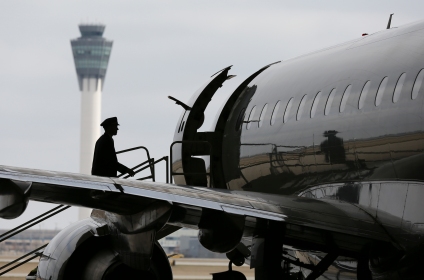
By Kathryn B. Creedy
- Pilot shortage threatens airline growth
- Shortage, rising pay driving unprecedented demand of automation
- Shortage of CFIs, DPEs create months-long bottlenecks
- Limited training resources, simulators exacerbate the problem
- Pilot bad mouthing industry, pay is real reason for shortage
- Pilot recommendations on CBT/EBT suggest US out of step in training
- Current pilot trainers can’t fly the line in the US while their foreign students return home to begin their careers.
As the Federal Aviation Administration convenes an historic Workforce Summit on September 13 in Washington, the industry must consider several trends conspiring to limit, not expand, pilot jobs. It is very likely the pilot shortage is backfiring as these trends reveal it will have its worst effect on pilots themselves.
Hyberbole? Reporting on both flight deck automation and the fact the shortage is limiting airline growth is increasing.
The first trend threatens the health of the industry because it means airlines won’t be able to grow thus limiting pilot jobs. Passenger demand is expected to double by 2035 while e-commerce is creating a boom in the cargo industry. Where are we to get the pilots?
Demand is pushing the second trend. The pilot shortage has provided an unprecedented urgency driving advances in automation that will ultimately put pilots out of a job. Airbus and Boeing are already there because we simply can’t train enough pilots fast enough to avoid the problem.
Quantifying the Problem
Cowen and Company keeps a very close eye on pilot demand and provides one of the best forecasts in the industry. Last year, it said by the end of 2026, about 42% of the active pilot workforce at the five largest airlines will retire. Recently, it said in its latest pilot report, the Big 4 – American, Delta, United and Southwest – will need 44,000 pilots in the next 12 years to replace retirements and accommodate a small 1% growth rate, far less than the anticipated of 3% which would require 65,000 pilots. Every percentage point requires 10,000 pilots.
The regional industry pilot workforce is estimated at 20,000 pilots. The top 11, said Cowan, have 14,000 pilots.
Boeing Global Services Director – Air Crew Operations Carl Davis reported during the World Airline Training Summit (WATS) Conference the world will need to hire and train 32,000 pilots annually to accommodate the demand it forecast.
But the lack of airline growth is only part of the problem. While few disagree rising regional pilot pay is long overdue, pressure on pilot pay it is also a substantial headwind at a time when airlines are having a hard time raising revenues, especially coupled with rising fuel costs. The obvious solution is looking for alternatives.
Shortage drives automation
Consequently, the pilot shortage is also driving advances in automation to the point few will be surprised to see single-, or even, no-pilot flight decks in the next 30 to 50 years. Unions are already fighting proposals to test it in the cargo industry.
We are definitely not ready for such automation but as it is proven on the ground and in the air, passengers will not think twice about boarding an unstaffed commercial aircraft. It will mean redesigning aircraft and making them highly augmented to accommodate single-pilot operations, according to Airbus. It will also meaning changing training programs.
While pilots cite the Miracle on the Hudson and the successful landing of Southwest 1380’s un-contained engine failure as reason to oppose no-pilot or even single-pilot ops, proponents have turned that safety argument on its head. “Pilot error,” they say, “is responsible for the majority of accidents, so, if you take the pilot out of the equation….”
It’s a reasonable argument. “What if the pilots hadn’t been there in the Asiana crash,” asked AirInsight’s Addison Schonland. “There might not have been a crash.” We do know automation has been a factor in crashes in which pilots relied too much on it while failing, or not knowing how, to fly by the seat of their pants. The Air France 447 also comes to mind but there are many others. Indeed, such accidents forced changes to training to ensure pilots not only know how to avoid stalls and upsets but how to get out of them.
Frightened Pilots
With good reason, pilots are so frightened about eliminating the human flight deck, they put on the usual, full-uniform display to oppose a provision in the FAA reauthorization to even study the issue. Their objection is political posturing; studies are ongoing because Boeing, et al don’t need union permission.
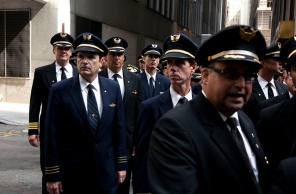
Source: Dan Nguyen
And, it is hard to argue with the cost savings. At WATS, Airbus suggested single-pilot ops could yield $60 billion in savings in pay, benefits and operational efficiencies.
Regardless of the speed of automation, two other trends will also impact pilots. The increase in both the density and size of aircraft and increasing utilization, further limit pilot opportunities.
Then there is the shift beyond aircraft manufacturing to services. Pilots were upset when Boeing provided pilots to replace some Avianca-Colombia pilots who were fired for striking. The pilots were not actual Boeing employees but were from Cambridge Communications Limited, a contractor supplying pilots to Boeing, according to Forbes Contributor Ted Reed. But it does show an entire industry has developed for sourcing pilots which has implications for unions.
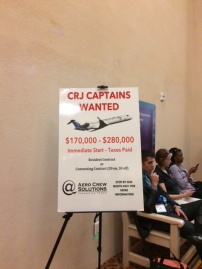
Source: Kathryn B. Creedy
Conflicting Support Among Union Rank and File
“I really think ALPA is declining into irrelevancy and only has itself to blame,” a union member told me during WATS. Since then, so many members have echoed that sentiment or indicated their displeasure with the union as pilot shortage debates blow up online, as to open my eyes to the many problems the union has.
However, other pilots argue with me over Twitter or LinkedIn, reverting to antiquated rhetoric about “scum-bucket” regionals refusing to pay a decent wage as if that were in the regionals’ control. They refuse to acknowledge the role of the CPAs and unions’ own role in failing to advocate for better regional pilot conditions at the mainline level.
These pilots insist there is no pilot shortage but, rather, a pay shortage, which could not be further from the truth since regional pay has risen dramatically and tens of thousands in bonuses have become part of base pay. Regionals are also offering tuition assistance.
Bad Mouthing the Industry Counterproductive
Harping on a pay-shortage is a double-edged sword. The more they talk about low regional pay the more aspiring pilots are dissuaded from pursuing a career that costs them more than $150,000 and years of time before they can qualify.
There is also an anomaly which is driving current pilots crazy, further alienating them. As CFIs they are training foreign pilots who then return to their home countries to fly the line while they stay home drilling holes in the sky to build hours that the NTSB and other safety experts say is a poor metric for pilot quality.
And then there is four decades of bad mouthing the profession which is, I think, the real reason we face a pilot shortage today.
For more than two generations, pilots spent most of their public time complaining about how bad they were treated and how bad their jobs were. While this may have been union posturing, the message got through. Case in point: Congress called Captain Sullenberger to Capitol Hill to bask in his reflected glory shortly after the 2009 Miracle on the Hudson. He spent the majority of his time complaining about how bad his job was. Half way through the hearing, I thought to myself, “no wonder no one wants to be a pilot” and that was before I knew how much it cost.
Ironically, this was at the same time of the Colgan crash when almost the entire narrative was about low pilot pay. We all remember the rhetoric about qualifying for food stamps which is still entrenched in the public mind because pilots still use that talking point.
While ALPA can point to the dramatic regional pay increases and say Mission Accomplished, it has come at a cost of discouraging interest in the career, despite rising enrollment.
Historic Interest Not Indicative of Pilot Future
Today, we are at an historic high in interest in becoming a pilot. Universities report rising enrollment. The entire industry is pulling out all the stops to tout the glamour of becoming an airline pilot. Aviation programs designed for middle and high schoolers are developing all over the country. But that is not what it seems.
“The FAA’s 2018-2038 Aerospace Forecast shows the number of civil aviation pilots moving in the wrong direction, relative to the demand projected by the aviation industry,” noted The Pilot Liberator on Twitter, recently, posting a chart from the FAA’s latest forecast.
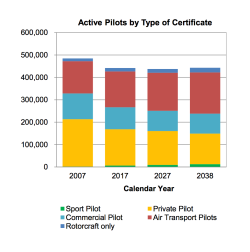 But rising enrollment has also forced two allies in the fight to eliminate the 1500-hour rule apart. At the Spring RACCA meeting, UND Professor and Director of Aviation Industry Relations Kent Lovelace warned airlines not to poach CFIs because that would break the pipeline once again. The statement was greeted with a dull thud on an audience facing few alternatives.
But rising enrollment has also forced two allies in the fight to eliminate the 1500-hour rule apart. At the Spring RACCA meeting, UND Professor and Director of Aviation Industry Relations Kent Lovelace warned airlines not to poach CFIs because that would break the pipeline once again. The statement was greeted with a dull thud on an audience facing few alternatives.
We also heard JetBlue Senior Vice President Safety, Security and Air Operations Warren Christie explain the airline’s ab initio program takes 4-5 years despite the fact it takes half that time to teach them how to fly an airliner. American also created an ab initio program but, combined, these two programs will produce only a handful of pilots at a cost between $100,000 and $125,000 to each candidate.
Then there are all the bottlenecks students face beyond costs. The industry is facing a widespread lack of resources including flight instructors and designated pilot examiners which force months-long delays. Airlines, training and simulator companies all report a shortage of sim time which impose further delays. Carriers are using double and even triple the amount of time to get a new hire through the training because of these shortages.
So, even if we could attract the pilots needed to replace those retiring in the next dozen years, we can’t train them fast enough because we don’t have enough resources to get the job done.
The rest of the world is confronting the shortage by redesigning training programs around Competency/Evidenced-Based Training (CBT/EBT) which streamlines training while being careful not to dilute safety. These programs were developed by pilots, by the way, but my pilot contacts on Twitter reject such programs as the Multi-Crew Pilot’s License which is accepted around the world.
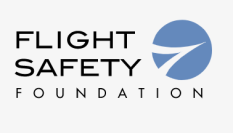
US mainline pilots prefer instead the time-consuming, lock-step licensing method that begins with the private pilot license and, several long steps later, ends, for those seeking a career, in the ATP. They say safety experts – the Flight Safety Foundation and Royal Aeronautical Society, for instance – pushing pilot-developed CBT/EBT are just industry fronts out to compromise safety.
The JetBlue ab initio program embraces CBT/EBT but the regional industry’s efforts to adopt it has been stymied by the same political interests that gave us the nonsensical 1500-hour rule.
Boeing’s Davis discussed at WATS 2018 what customers want when they contract for pilots. High in their requirements is CBT/EBT.
Last Generation of Pilots
I question how long this historic interest in piloting will last. A decade? Fifteen years?Those entering the industry today will, no doubt, have long, lucrative and productive careers. But what about the next generation? How enthusiastic will they be to invest $150,000+ in the career if what they see in the end is being replaced by a computer? Automation promises a new kind of job in the future but as we have seen in the last 30 years, it has also meant fewer jobs and the necessity to retrain which has never happened on the scale needed.
Solutions today are piecemeal. There are workforce bills working their way through Congress and efforts to overcome the 1500-hour rule. But they will do little if the training capacity is not expanded and if US pilot development remains unchanged. What is needed is what I called for two years ago when I wrote my landmark Forbes Online pilot shortage series calling for a wholesale redesign of the pilot training to streamline the process while retaining safety.
It’s already been done in the rest of the world so why can’t we do it in the US?

I’m a pilot and hate it. The hours can be horrible, it can fatigue you beyond the capacity to perform safely but still be within regulation duty times. Ameriflight cargo airline fired me because I was in hurricane Maria in Puerto Rico. All airlines want to do is dangle money in front of you to hook you into joining them. But the workload and schedule is terrible. Working nights, holidays, weekends. It’s just not worth it. And forget flight instructing. It pays nothing and they expect you to work 7 days a week. It’s awful. Right now I’m not flying because Ameriflight stripped me of my aviation love and reassessing my flying future.
LikeLike
https://www.linkedin.com/pulse/demystifying-pilot-shortage-mariano-andr%C3%A9s-magari%C3%B1os/?lipi=urn%3Ali%3Apage%3Ad_flagship3_profile_view_base_post_details%3BUruaQjtNTcSM%2BFzIKHlpDg%3D%3D
LikeLike
As usual, a non-airline employee and non-professional pilot writes an article completely out of touch with reality, but rewarded by smiles and nods from the FAA and Airline Management. This article was a bloated, massive shot across the bows at not only unions but more specifically professional pilots. Keep it up. The more you demonize us, the more it reminds us that the poor pay and quality of life inflicted on us has come home to roost.
LikeLike
As a matter of fact, I don’t demonize you. I merely report on the fact that the ALPA line is completely out of touch with the expertise of pilots from around the world who are way ahead of us in many ways. It is also out of touch with training experts. Far from being an apologist for airlines and regulators, I’ve written on how they have failed. If you take the time to read my entire 5-part Forbes series, you will see. https://www.forbes.com/sites/kathryncreedy/2016/02/04/pilot-training-requires-regulatory-overhaul-to-improve-safety-part-i/#6fcfe25e40b8
Yes, I see ALPA as the main protagonist but only because it refuses to come into the 21st Century and it is so easy to hoist it on its own petard using the combined expertise of safety experts (including many pilots) from around the world. Its statements defy belief. I can’t help it if union stances are so easily shot full of holes. That is on the unions, not me.
And one more thing. I wish you guys would learn how to really debate. Demeaning your opponent is amateur and loses you points. It is also not a logical opposition statement.
The article was in no way a “shot across the bow” of professional pilots. It was coverage of the reality they are facing in their careers and the loss of a great profession. After all they have been through since 2000 — bankruptcies, givebacks, loss of pensions, abused, this is their future. It is very sad and tragic but it won’t be the first such loss or the last. Journalists are not exempt either.
Your poor pay, ridiculous work rules and so many other things about your life a shame but I don’t see unions doing much about that, at least at the regional level. I’ve written a lot on how work rules need to change and no one is doing squat — except of course for women pilots who have been belittled and ignored at unions. https://www.linkedin.com/pulse/better-worklife-policies-key-increasing-women-pilots-part-creedy/
LikeLike
This is why we need to insert work/life balance into work rules to accommodate the demands of the modern worker.
LikeLike
You raise some interesting points but I disagree with you when you say regional airlines have sufficiently increased pay. The bonuses and small pay increases are certainly a move in the right direction, but hardly enough to attract pilots who wish to stick around long term. They’re a bandaid at best. While I agree the mainline unions may play a role in maintaining the status quo, the ROI is hardly attractive to someone contemplating a $150,000 investment in their education.
Pilots have been the victims of a roller coaster aviation market combined with supply and demand curves stacked against them for decades…who can blame them if they want to see an equitable correction.
LikeLike
Patrick, thanks so much for taking the time to comment. The bonuses are now part of base pay as I always knew they would be. Pilots are not going to stick around long term no matter the pay when what they really want is to fly big metal. The ROI is attractive if you look at for every dollar spent you get $3 in return over the course of your career. Leastways that is the calculation ALPA gave me. It may no longer be true. I think you are right pilots have been the victims and sadly it is only going to get worse. I am still angry about the loss of pensions which I thought was an immoral act. But then again, most of us who saved through a 401K were ripped off, too. The problem is pilots think their career or their industry it is somehow special. It is not. What has been happening to pilots since 2000 at least, happened in many other industry first.
LikeLike
That ROI is only true if you make it to a major airline. Not all who start will. In fact, the odds are greatly against them. You’re also looking at a changing demographic in today’s teens and college students. Most of them have neither the determination nor stamina to stomach a $150k+ investment and 3-5 years of their life just to get a mediocre-paying Regional job for another half-decade with the CHANCE of getting to a major. Not to mention the huge increase in ADD/ADHD diagnoses in nearly 25% of the young population (and growing) is the basis for denial of an FAA Medical. All of that together with retirements is going to cause more problems than you yet realize. As professional pilots we talk about this quite a bit. Won’t matter for us, but it will for our children interested in the profession.
LikeLiked by 1 person
Patrick, the wage raises at regional were LONG overdue. The problem is the capacity purchase rates dictated by mainlines. Without reform regional pay will never get where it needs to be. That is why I’ve advocated for a holistic approach to pilot pay. Unfortunately, mainline pilots have never advocated appropriately for regional pay and, in fact, that is why regional pay was so low to begin with.
I saw a figure today that $16 million in career pay for the $150k investment. Not bad but that $150k is still two high. We need training reform as I’ve been advocating for years. That reform is based on what pilots have cited as the essential skills and how to train for them. They are already widely accepted around the world but not in the US because of ALPA.
LikeLike
Demystifying “PILOT SHORTAGE”Almost thirty years ago, when I started my career in aviation they still were there, very small, doubtful and disperse articles in magazines (no internet at that time) about the pilot shortage.
We all grew up, in aviation, with this topic, and three decades later, here we are, nothing happened and nothing will happen with the pilot shortage.
In those early days I didn´t understand what the shortage was about, but after years (lots of them) of studying, analyzing, evaluating and contrasting information from every source and from all over the world we can assure based on the past, history, future and with overwhelming evidence that the PILOT SHORTAGE IS A MYTH.
To go further, I wrote six (one in Spanish) articles addressing this “lobby”, answering hundreds of post, and the most current example of this lie that covers a lobby to cut working conditions is RYANAIR (only an example), the one that is willing to fire 300 hundred crews (that claim fair working conditions) and on the other hand and at the same day they are (or seems to be) recruiting non-permanent jobs via brokers, so the game its crystal clear.
Is obvious that if the industry keeps trying to destroy well established and safe Airlines, cutting working conditions and only are favourable to intermittent contracts with poor terms and cond´s it is OBVIOUS THAT NO ONE WILL embrace this expensive and hard career to become an airline pilot, and then, they will get their precious and desired shortage.
And by the way, this harmful malicious MYTH is creating the fake need or feeling that this shortage will damage the industry, so the single pilot operation or even the remote operation will be granted and justified!!
Looking for more info on this topic?
Six articles for six MYTHS- THE PILOT SHORTAGE MYTH a harmful and damaging myth.
https://www.linkedin.com/pulse/las-aerol%C3%ADneas-de-bajo-costo-desatan-una-guerra-por-los-magari%C3%B1os/
https://www.linkedin.com/pulse/airline-pilot-shortage-could-myth-mariano-andr%C3%A9s-magari%C3%B1os/?lipi=urn%3Ali%3Apage%3Ad_flagship3_profile_view_base_post_details%3B%2BoAgseQ3TjyqSInh1VdXdw%3D%3D
https://www.linkedin.com/pulse/rest-assured-airline-pilot-shortage-its-myth-mariano-andr%C3%A9s-magari%C3%B1os/?lipi=urn%3Ali%3Apage%3Ad_flagship3_profile_view_base_post_details%3B%2BoAgseQ3TjyqSInh1VdXdw%3D%3D
https://www.linkedin.com/pulse/pilot-shortage-myth-part-2-mariano-andr%C3%A9s-magari%C3%B1os/?lipi=urn%3Ali%3Apage%3Ad_flagship3_profile_view_base_post_details%3B%2BoAgseQ3TjyqSInh1VdXdw%3D%3D
https://www.linkedin.com/pulse/airline-pilots-myth-part-3-australian-shortage-like-wiht-magari%C3%B1os/?lipi=urn%3Ali%3Apage%3Ad_flagship3_profile_view_base_post_details%3B%2BoAgseQ3TjyqSInh1VdXdw%3D%3D
https://www.linkedin.com/pulse/pilots-shortage-myth-part-4-mariano-andr%C3%A9s-magari%C3%B1os/
LikeLike